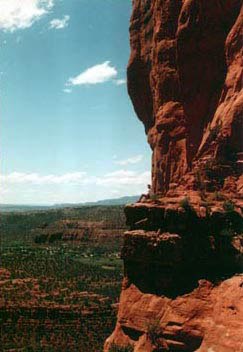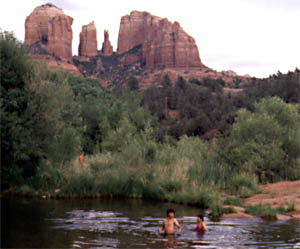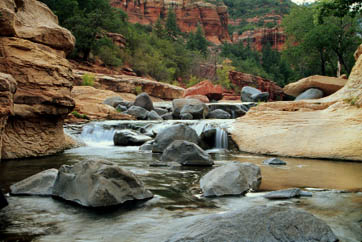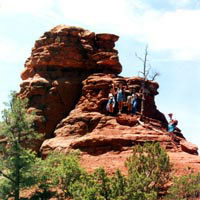Geotimes

Travels
in Geology March 2004
Red Rock Country
 Gorgeous
red sandstone adorns much of the West, but arguably, none is as magnificent
as that in Sedona, Arizona. Nestled south of the snowy mountains and north of
the notoriously scorching Arizona desert, Red Rock Country stretches across
wind-whipped mesas, through canyons carved by water millions of years ago and
into villages inhabited by Native Americans thousands of years ago. Layered
red, yellow, gray and white cliffs 3,000 feet high mark the edges of the canyons,
through which sparkling streams tumble and supply sustenance to wildflowers,
juniper and pine trees.
Gorgeous
red sandstone adorns much of the West, but arguably, none is as magnificent
as that in Sedona, Arizona. Nestled south of the snowy mountains and north of
the notoriously scorching Arizona desert, Red Rock Country stretches across
wind-whipped mesas, through canyons carved by water millions of years ago and
into villages inhabited by Native Americans thousands of years ago. Layered
red, yellow, gray and white cliffs 3,000 feet high mark the edges of the canyons,
through which sparkling streams tumble and supply sustenance to wildflowers,
juniper and pine trees.
Climbing Cathedral Rock, as the formation
at left is called, is not for the faint of heart. But trips abound for hikers
of all levels. Photo courtesy of HikeSedona.com.
Just 25 miles south of Flagstaff along Route 89A, 85 miles southeast of the
Grand Canyon and 110 miles north of Phoenix, Sedona is easy to reach, whether
you plan to stay for awhile or are simply driving through. Here, the sun shines
an average of 350 days of the year. And with its dry air, high altitude (the
town is at 4,500 feet above sea level), varying topography and temperate climate,
the Sedona area is a haven for outdoor activities. One word of caution if you
plan on driving through Sedona without stopping — the area's captivating
scenery might just render you unable to leave.
Explore Sedona, Ariz., via horseback,
foot, mountain bike or jeep in Coconino National Forest,
pictured at right. Coconino also offers swimming, fishing and camping opportunities.
Photo from U.S. Forest Service.
Like most red sandstones across the West, iron oxidation fashioned Sedona's
famous face. Now situated at the southern edge of the Colorado Plateau, the
Sedona area was an underwater volcanic environment during the Precambrian. The
oldest rocks that can be seen are about 1.8 billion years old. The entire history
of the area is visible in sedimentary rock layers deposited over millions of
years, as the region went from submarine to desert to shallow marine and back
to coastal plain and desert over time. Erosion from winds, water, ice and rock
falls created the more than 15 separate rock formations, which encompass eight
geologic time periods.
The terrain varies so drastically, from sheer cliffs to flat mesas (with everything
else in between), that there are enough hiking trails to accommodate every type
of hiker, from first-timer to mountain climber. And as you drive through the
region, every few miles you'll see a trailhead where you can pull over for a
hike. Alternatively, you can visit one of the many Internet sites devoted to
hiking trails in Arizona before you leave home and print out a trail map. If
you plan on hiking though, be sure to bring plenty of water.
One of the most popular hiking spots in the region is Oak Creek Canyon, which
Oak Creek began eroding around 12 to 15 million years ago and kept going until
the canyon reached more than 2,000 feet deep into prehistoric times. No trip
to Sedona is complete without at least wandering through the canyon, which you
can do at any level of difficulty and time you choose. You won't be disappointed
— the lush vegetation, stream bubbling over red rocks and sun shining on
the cliffs will leave you with lasting memories.
Slide Rock State Park
runs right through Oak Creek Canyon, and includes some of the best hiking trails
in a region known for its trails. Photo from Arizona State Parks.
Mountain biking is also a good option around Sedona, as is horseback riding.
Or, for the truly adventurous, try a hot-air balloon tour of the region. As
tourism is the core industry in Sedona, many companies offer whatever rental
equipment, maps or guided tours you could possibly want.
Accommodations abound in the resort towns of Sedona and Oak Creek, although
they can be pricey. But if you have the time and money to spend on your vacation,
check out one of the renowned bed and breakfasts or spa resorts. Many Sedona
visitors also stay in Flagstaff, which is a bit larger than the resort towns.
Of course, there are also plenty of campgrounds throughout Coconino National
Forest if you prefer roughing it. Wherever you stay, one good way to start your
exploration is to rent a jeep; pack your hiking boots, water and gorp, and head
out.
Whether traveling with friends, family
or solitaire, Sedona is an outdoor lovers' paradise. Photo courtesy of HikeSedona.com.
And if you want a change of scenery, try one of the many popular golf courses
in the area or visit the "healing spas." Myths dating from the first
settlers of Sedona — Native American tribes — surround the healing
powers of the rock, and visitors flock to the spas to heal body and soul.
Megan Sever
Links:
Sedona
Visitor's Information
Coconino
National Forest Hiking Guides
Sedona
Hikes
Arizona
State Parks
Read more Travels in
Geology
Back to top
 Gorgeous
red sandstone adorns much of the West, but arguably, none is as magnificent
as that in Sedona, Arizona. Nestled south of the snowy mountains and north of
the notoriously scorching Arizona desert, Red Rock Country stretches across
wind-whipped mesas, through canyons carved by water millions of years ago and
into villages inhabited by Native Americans thousands of years ago. Layered
red, yellow, gray and white cliffs 3,000 feet high mark the edges of the canyons,
through which sparkling streams tumble and supply sustenance to wildflowers,
juniper and pine trees.
Gorgeous
red sandstone adorns much of the West, but arguably, none is as magnificent
as that in Sedona, Arizona. Nestled south of the snowy mountains and north of
the notoriously scorching Arizona desert, Red Rock Country stretches across
wind-whipped mesas, through canyons carved by water millions of years ago and
into villages inhabited by Native Americans thousands of years ago. Layered
red, yellow, gray and white cliffs 3,000 feet high mark the edges of the canyons,
through which sparkling streams tumble and supply sustenance to wildflowers,
juniper and pine trees.



